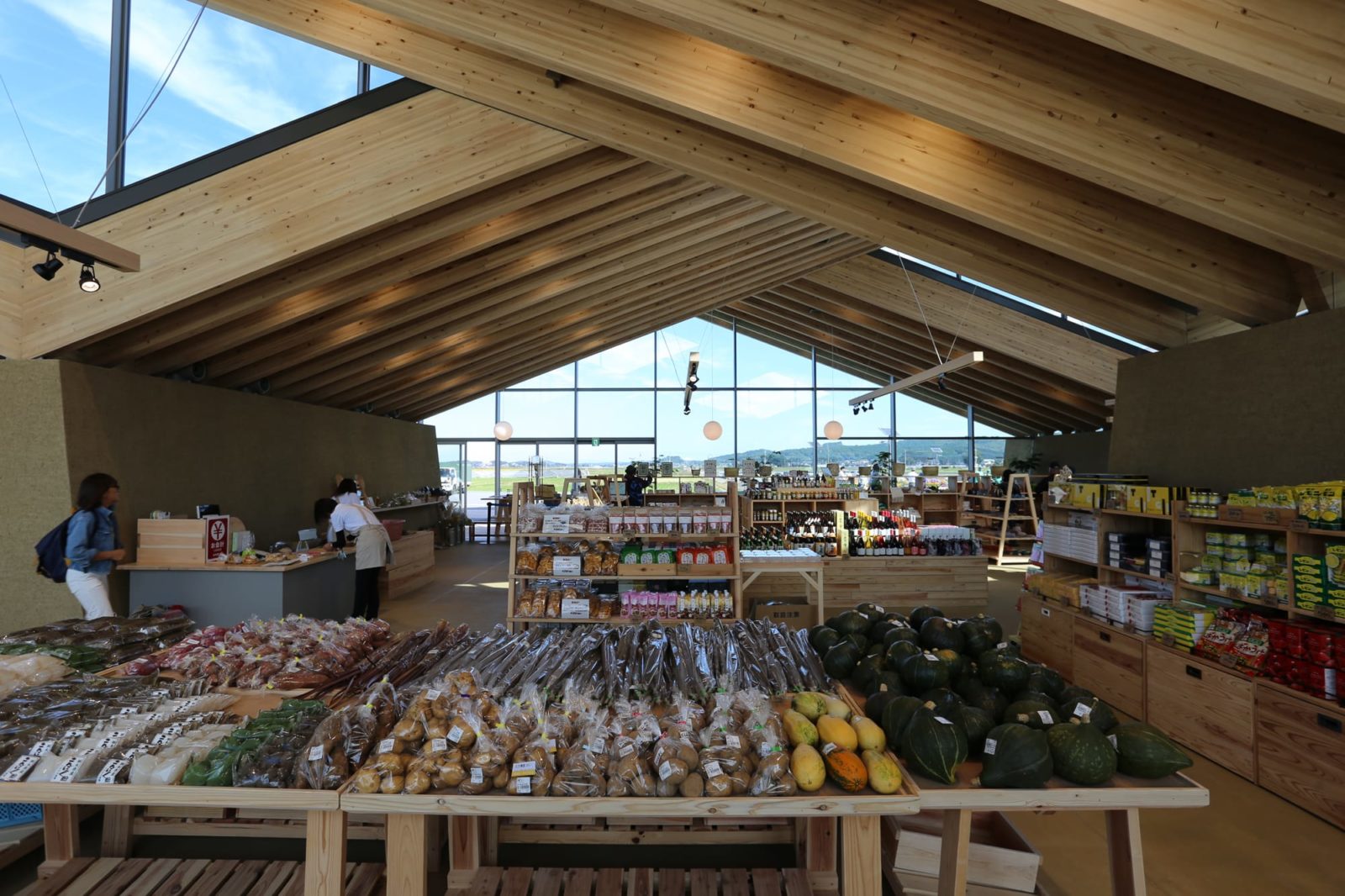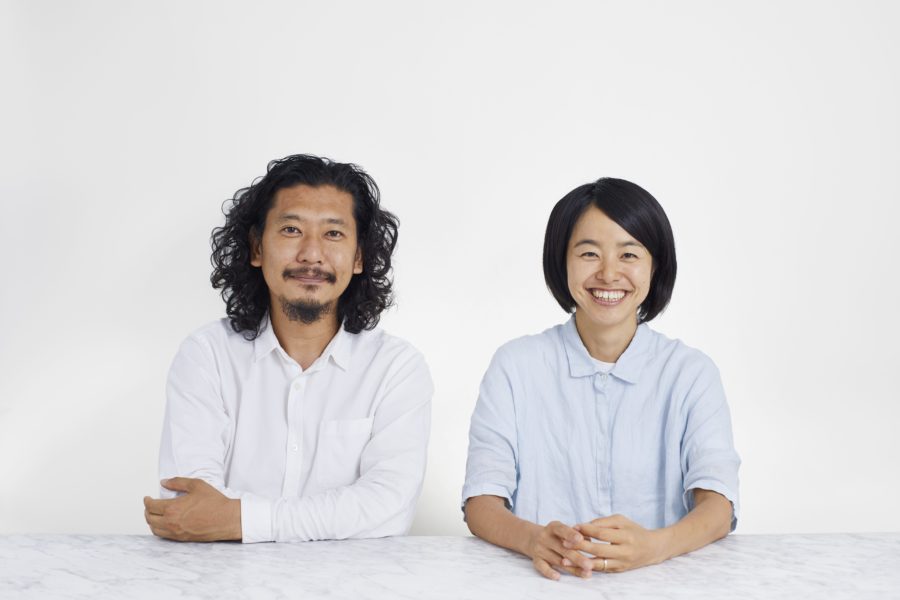建築が本来もつ領域に広がっている
──〈道の駅 ましこ〉のプロセスやあり方を伺うと、建築の役割が変わってきているように感じます。
麻魚:「建築には役割がある」と思っていたけれども、実はその役割って非常に限定的なもので。
我々が定めていた以上の役割が、建築には本来あったのだと思います。
そうした建築本来の役割に今、伸びているというか、広がっているというか。そういう感覚ですかね。
現在の建築のあり方というのは近代以降に定まったところがあったけど、実はそれ以前から持っている役割があって。
それが今もう一度、建築の世界に含められているということで、それはすごくいいことだなと思います。
真宏:ざっくりとした切り方をすれば、これまでの現代建築の主題は「空間」だったよね。
永遠に歳をとらないというか、ある瞬間で固められたあり方という感じがするんだけれど、これからあるべき良い建築のデザインとか形式というのは、空間と時間を両方解くようなものだろうなと思いますね。
建築で考えることのできる領域がすごく広がってきて、それはまた豊かだなという感じがします。
麻魚:先日、東京大学の加藤耕一さんという建築史の先生と話していたとき、建築で時間軸をどう評価していくかという話題になりました。
それは、建築にもともと備わっていた役割だったり魅力だったりしますが、今はそっちに向かって開いていて。決して懐古主義ではなくて、すごくポジティブで冒険的だと思います。
真宏:これからつくる建築は社会がサステナブルとしなければ私たち自身が滅亡してしまうので、考えざるをえなくなっているんでしょうね。
僕たちの場合は、伐った木を使ってみたいなと思ったりしていて。生き続けていくサイクルの中に、建築をもう一度入れないといけないな、と思います。
It expands into the realm of architecture
I feel that the role of architecture is changing when I hear about the process and form of the Mashiko roadside station.
Mao: I used to think that architecture had a role to play, but that role was very limited.
I think architecture had an essential role to play beyond what we had set out to do.
It seems that the primary role of architecture is now expanding, or is it expanding? I guess that’s the feeling.
The current state of architecture has been established since the modern era, but it has also had a role to play even before that.
I think that’s a great thing because it’s now being included in the world of architecture again.
Masahiro: Roughly speaking, the central theme of contemporary architecture so far has been “space.”
It seems to me that it doesn’t age forever, that it’s just a fixed way of being in a given moment, but I think that good architectural design and form in the future should unite both space and time.
I feel that the area where we can think about architecture is expanding a lot, and it’s also enriching.
Mao: The other day, when I was talking with Koichi Kato, a professor of architectural history at the University of Tokyo, we were talking about how to evaluate the time axis in architecture.
That’s the role and appeal that architecture originally had, but now I’m opening up to that. It’s not nostalgic at all, and it’s very positive and adventurous.
Masahiro: I think we are forced to think about the architecture we are going to create because if society doesn’t make it sustainable, we will perish.
In our case, we wanted to make use of the trees we had cut down. We need to include architecture again in the cycle of living.

麻魚:これまで私たちが設計した建築にはコンクリートもありますし、鉄骨もありますけど、すべてにおいて素材やつくり方に目を向けています。
時間や使われ続けていくことの意味を念頭に置くからこそ、素材とかつくり方、構造や工法に興味がいくのですよね。
建築をモノとして扱うというのは当たり前なようでいて、難しくて、おもしろいと感じます。
真宏:死んだものではなくて、エネルギーを循環させていくもの。その側面でも合理的でないといけないなと思うよね。
麻魚:車輪を最初からぐるっと回しているような感覚はありますよ。ごろん、ごろんとこの後に転がっていったらいいなと。
真宏:比喩にすると難しくなるよ(笑)。
Mao: The buildings we’ve designed so far include concrete and steel frames, but in all of them, we focus on the materials and the way they are made.
It is because we keep in mind the meaning of time and the fact that it will continue to be used, that we become interested in materials, construction methods, and construction methods.
It seems natural to treat architecture as an object, but I find it challenging and exciting.
Masahiro: It’s not dead; it’s something that circulates energy. I think you have to be reasonable in that aspect as well.
Mao: It feels like you’re spinning the wheel in circles from the beginning. It would be nice if it would roll over after this.
Masahiro: It isn’t easy to use a metaphor (laughs).

多様性に飛び込んで軸を指し示すのが建築家
──普段の設計で、お二人の役割分担はあるのでしょうか?
麻魚:役割分担は特にないですね。おのずとテクニックや手法、キャラクターとか、そういう部分の違いはもちろんあると思うんですけれど、方向性や興味はある程度は共有しています。
そのなかで違いが出てくるのは、むしろいいかなという気がしますね。太くなるというか。
──建築家の役割については、変わってきたと思われますか?
真宏:もともと僕が建築をやっているのはエゴイスティックな理由からで、美しい風景のなかに暮らしたい、ということなんです。
建築家には、それができると思ったので。実際に、自分たちの環境を自分たちの手で変えていくことができるわけだから。
それも、ある定まった道筋に沿って意図のままにカチッと動かしていくというより、より楽しく活き活きと未来に向かって運動していく状況に整えてあげるようなかたち、あるいは雛形をつくるというのが建築家なのかもしれません。
そのとき混沌とか複雑な状況とか、多様なものの中に飛び込んでいって、そこから調和というか、ユニティを見出していくのが建築家の役割であると思っています。
見たいところだけ見ていくのは簡単ですしそうした風潮もあるけれど、建築家はもっと広範に見て、大きな世界の中から開いた秩序をつくっていくべきなのだろうなと。
そうした点では、建築家の役割はこれからも変わらないと思います。
麻魚:私は学生などに「道に迷うような状況で、北極星のほうを1人ビシッと指差す、それが建築家」と言うことがあります。
我々が求めている大きな流れ、もしくは我々がこのあと想像しなければいけないリアルな軸を、ぐちゃぐちゃした多様性の中から見つけ出して、それを指差す。
そういう人が建築家かなと思っています。
それって意外と古典的なんですけれど、指を差すそのものの価値だけでなく、そうすることで仲間ができて共感される。そして、ストーリーをていねいに紡いでいく。
建築家として、そうした次元にまで世の中の人に気が付かれるようになっているのかなと思います。
これまでも建築家の役割は探し求められてきたことですが、昨今はリモートワークもできるなかで、どう活動するかに注目しているのが現状ではないかと思います。
最終的には、みんなが北極星を指させるようになってほしいですね。そうした気づきの連鎖みたいなものを、呼び起こしているつもりです。
〈道の駅 ましこ〉では、1人1人が「ここが良いんだ」と指差し始めていて、さざ波が立っている。
その状況が共感を生んで評価されたのかなと思っていますし、そうすると喜びもバーッと広がるんです。それが何よりも嬉しいですね。
An architect who dives into diversity and points out the axis
Is there a division of roles between the two of you in the usual design?
Mao: There’s no particular division of roles. Of course, there are differences in techniques, methods, characters, and so on, but we all share a specific interest and direction.
I think it’s rather lovely to see the differences that come out of that. It’s like getting fat.
Do you think that the role of the architect has changed?
Masahiro: The reason I’m doing architecture is for selfish reasons. I want to live in a beautiful landscape.
I thought the architects could do that. We can change our environment on our own.
Rather than following a set path and making things click as intended, the architects may be trying to create a shape or template that will make a more enjoyable and lively move toward the future.
I believe that it is the role of an architect to dive into the chaos and complexity of diverse situations and to find harmony or unity in them.
It’s easy to look only at what you want to see, and there is a tendency to do so, but I think that architects should look more broadly and create an open order from within the larger world.
In this respect, I think the role of the architect will continue to be the same.
Mao: I sometimes tell my students, “When you’re in a situation where you’re lost, one of you points to the North Star, and that’s an architect.
We find the significant flow that we are looking for or the real axis that we have to imagine in the future and point to it in the mangled diversity.
I think that kind of person is an architect.
It’s surprisingly classic, but it’s not only the value of pointing a finger but also the companionship and empathy that comes from doing so. He or she then carefully spins the story.
As an architect, I wonder if people in the world are becoming aware of this dimension of the architect’s work.
The architect’s role has always been sought after, but nowadays, with the ability to work remotely, there is a lot of focus on how to do it.
Eventually, I hope that everyone will start pointing to the North Star. I’m trying to evoke that kind of chain of awareness.
At “Roadside Station in Mashiko,” one by one, people are starting to point out that this place is right, and there is a ripple in the air.
I think that the situation has generated empathy and appreciation, and when that happens, the joy spreads. That’s what I’m glad about more than anything else.

──アフターコロナで、建築や建築家はまた変化が求められそうですよね。
真宏:辛いことはたくさんありますけど、まあちょっと冷静に立ち止まって、自分たちが何をやっているのかを考えてみようという期間として捉えています。
ただ、僕たちが考えていることは、今もあまり変わっていなくて。大きくは2つあります。
1つは世界そのものを解釈していく喜び、抽象化して概念を得る喜び、そうしたものは手放したくないんです。
それは何かというと、例えば〈道の駅 ましこ〉であれば、建築ができたことで「里山のましこ」と言われるようになりました。それは、益子の概念が更新されたということです。
みんなで世界を解釈するようになった結果なのですね。
解釈した結果として、形式やデザインというものが生まれる。それは大きな喜びです。
もう1つは、創造する喜びです。解釈した形式を、今度はもう1度実体として世界へと投げ返し、つくり変えていくということです。
解釈することと創造すること、2つの回路で人がつながれていく。
その2つを僕たちは両輪としながら建築をつくっているし、それに共感していただけたのはすごく嬉しかった。
そして、その結果として風景がより豊かに立ち現れたということが今回の成果かなと思っています。【】
(2020.04.23 オンラインにて)
“After Corona,” it seems that architecture and architects are going to have to change again.
Masahiro: There are many hard times, but we see it as a period when we have to stop and think about what we’re doing.
It’s just that what we’re thinking about hasn’t changed much. There are two major ones.
One is the joy of interpreting the world itself, the pleasure of abstracting and getting concepts, and I don’t want to let go of those things.
For example, with the construction of “Roadside Station in Mashiko,” it has come to be called “Mashiko in the Satoyama.” It means that the concept of Mashiko has been updated.
It’s a result of how everyone has come to interpret the world.
The result of the interpretation is something called form or design. It is a great joy.
The other is the joy of creating. It means throwing the form you interpreted back into the world as an entity, again, and remaking it.
It is interpreting and creating two circuits that connect people.
These two things go hand-in-hand in our construction, and I was delighted that people shared my sentiments.
I think the result of this project is that the scenery has become more productive as a result. 【】
(Online on 2020.04.23)


